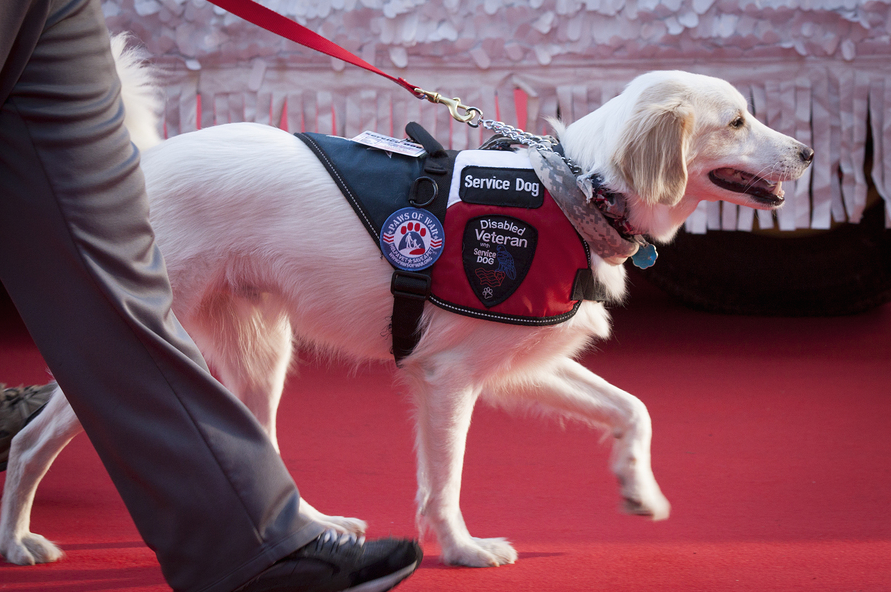Guest post by JME Thomas, Executive Director, Motley Zoo Animal Rescue. Motley Zoo Animal Rescue is a 501c-3 Not-for-profit Corporation based in Washington.

As the Executive Director of Motley Zoo Animal Rescue, I see a lot of interesting things: I see the best of people and the worst. Another thing I see are fads and patterns when it comes to people’s desires- especially, in regards to people requesting service dogs. This is now as common now as every fifth application we review- which means many people need dogs with very specific personalities and traits. It is when they follow that up with “needing a puppy so we can be sure to get what we want”, that I begin to worry.
That thinking couldn’t be more inaccurate.
When people request a service dog, we know they typically don’t need a dog that will literally help get them around; to be their eyes or ears. What they are usually seeking however is an emotional support or therapy dog. What’s the difference? A lot!
A service dog is one which is trained specifically to detect medical conditions such as seizures, or perform tasks or duties for a physically disabled individual, such as a Seeing Eye dog for the blind. These dogs require more than 2 years of intense training and development.
Emotional support animals (EAS) however, are those whose job is to be themselves: a companion to those who are psychologically disabled from issues such as panic attacks, PTSD (pot-traumatic stress disorder) or other debilitating mental challenges- ones that truly affect quality of life and day to day function.

A therapy dog on the other hand is a dog that is trained to provide comfort and therapy for someone- other than their owners- such as those dogs who visit the elderly in nursing homes or children in hospitals that need cheering up. There are also strict requirements for dogs to be registered as such.
Most people believe “dogs with jobs” as I collectively refer to them, are selected as puppies- but really, that couldn’t be further from the truth. While service dogs are selected for certain qualities as puppies, it can safely be said less than 50% of the puppies that start out as candidates, actually ever become one. But why? Especially with all that training?
Sometimes dogs don’t pass muster because of a health condition that develops, such as hip dysplasia- but most often it has nothing to do with training and everything to do with development. It’s simply their personality: they didn’t grow up to be the dog needed to do that very specific job. Much of the two years spent training a true service dog is actually for evaluating their personalities- not just teaching them what they need to learn.
Expectation and reality differing is pretty much “no duh”, when it comes to children. Somehow though this is baffling when applied to puppies.
Everyone knows parents work hard to mold their children the way they’d like, but how often is the outcome the same as the parents’ exact hopes or expectations? Perhaps it’s the football player dad who played catch every weekend with his son growing up, but when the son gets older, he prefers tennis…or *gasp*, maybe no sports at all! Or the piano aficionado’s child who grows up to be in a heavy metal band instead of joining the orchestra. Parents accept- and really, expect- their children will not be everything they hope or dream.
Very likely, neither will a puppy.
When seeking a dog to fill the “dogs with job” role, it’s a gamble when it comes to puppies. If you choose one, be sure you are prepared to accept responsibility for the dog, indefinitely, no matter how they may turn out. Your desire for a loving companion must take precedence over your desire for them to develop a specific way. Otherwise, it is terribly unrealistic and a heavy burden to put on your puppy who just wants to have fun and be themselves- as dogs should be allowed to do!
However, with adult dogs, “what you see is what you get”- especially dogs with proven experience, such as those in foster homes; those surrendered for the many reasons that have nothing to do with behavior issues. The shelter animals you see today, were most likely a family’s beloved pet the day before- as opposed to terrorizing the neighborhood as many envision. These are dogs that could make great dogs with jobs with very little extra effort- they are already what you’d need! Certainly more adult rescue dogs could fill the role of EAS dogs than couldn’t- and many can pass the requirements needed to become therapy dogs in the community too.

When selecting a dog to perform a job, look at who they are as individuals- not simply breed or age, which are really irrelevant. Frankly, like fine wine, many dogs get better with age! Even seniors can make great therapy dogs because they are not youthful spazzes, flopping on the leash, peeing on the floor and play mouthing everyone’s hands! You can better count on them for reliable, consistent and most importantly, calm behavior required of dogs with jobs.
For a great example of a rescue-turned-therapy dog, check out “Ottis to the Rescue” on Facebook. The page features the adventures of Ottis- long-time foster brother to hundreds of dogs and his “sister”, Nikki, a 15 year old, deaf and blind Pomeranian who is making the most of her golden years as a therapy dog in retirement homes. Nikki is a great example of a rescued dog that was selected as a therapy dog for her “perfect” intrinsic qualities already- not a puppy that was forced into a role he or she is not capable of living up to.
If you’re interested in some first-hand experience and advice, check out our interview with Brooke Mallory, Ottis and Nikki’s mom, here.
